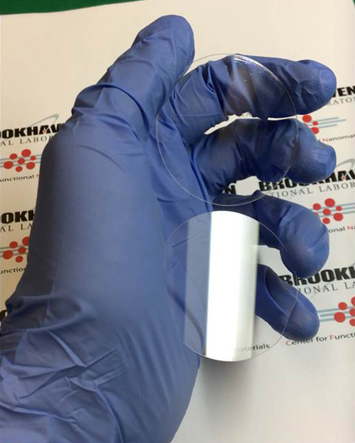Research Highlight: Can You See the Invisible Glass?
innovation at CFN
December 7, 2017

Photograph of a person holding a piece of regular glass (lower), which shows the reflection of an overhead fluorescent light, and a nanotextured piece of "invisible glass" (upper), which does not reflect the overhead light and remains completely transparent.
What is the scientific achievement?
Self-assembled surface nanotextures reduce light reflections from glass windows to less than 0.2 percent across the entire visible and near-infrared spectrum, rendering the glass essentially invisible. Silicon solar cells encapsulated with such “invisible glass” outperform conventional devices by eliminating all reflection losses. These ultra-transparent windows also withstand three times higher optical power than commercial broadband antireflection coatings.
Why does this achievement matter?
These ultra-transparent windows are useful for enhancing the user experience of consumer devices, improving solar cell performance, and enabling high-power pulsed laser applications.
What are the details?
Most optoelectronic components and consumer display devices require glass or plastic covers for protection against the environment. Optical reflections from these encapsulation layers can degrade the device performance or lessen the user experience. Here, we use a highly scalable self-assembly based approach to texture glass surfaces at the nanoscale, reducing reflections by such an extent so as to make the glass essentially invisible. Our nanotextures provide broadband antireflection spanning visible and infrared wavelengths (450–2500 nanometers) that is effective even at large angles of incidence. This technology could be used to improve the performance of photovoltaic devices by eliminating reflection losses, which can be as much as 8 percent for glass-encapsulated cells. In contrast, solar cells encapsulated with nanotextured glass generate the same photocurrent as when the cells are operated without a cover. Ultra-transparent windows having surface nanotextures on both sides can withstand three times more optical fluence than commercial broadband antireflection coatings, making them useful for pulsed laser applications.
Publication Reference
A.C. Liapis1,2, A. Rahman1,3, and C.T. Black1
1 Center for Functional Nanomaterials, Brookhaven National Laboratory, Upton, New York, 11973, USA
2 Wellman Center for Photomedicine, Massachusetts General Hospital, Harvard Medical School, Cambridge, Massachusetts, 02139, USA
3 Department of Physics, Indian Institute of Science Education and Research (IISER)-Pune, Pune, Maharashtra 411008, India
Applied Physics Letters 111, 183901 (2017)
Acknowledgement of Support
This research used resources of the Center for Functional Nanomaterials, which is a U.S. DOE Office of Science User Facility, at Brookhaven National Laboratory under Contract No. DE-SC0012704.
2017-12656 | INT/EXT | Newsroom









